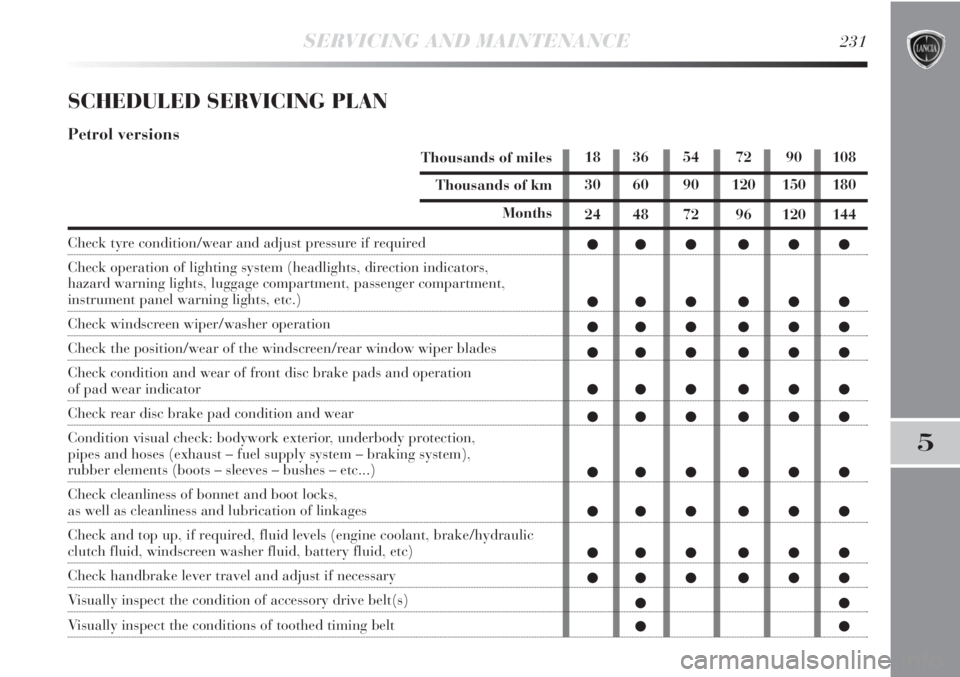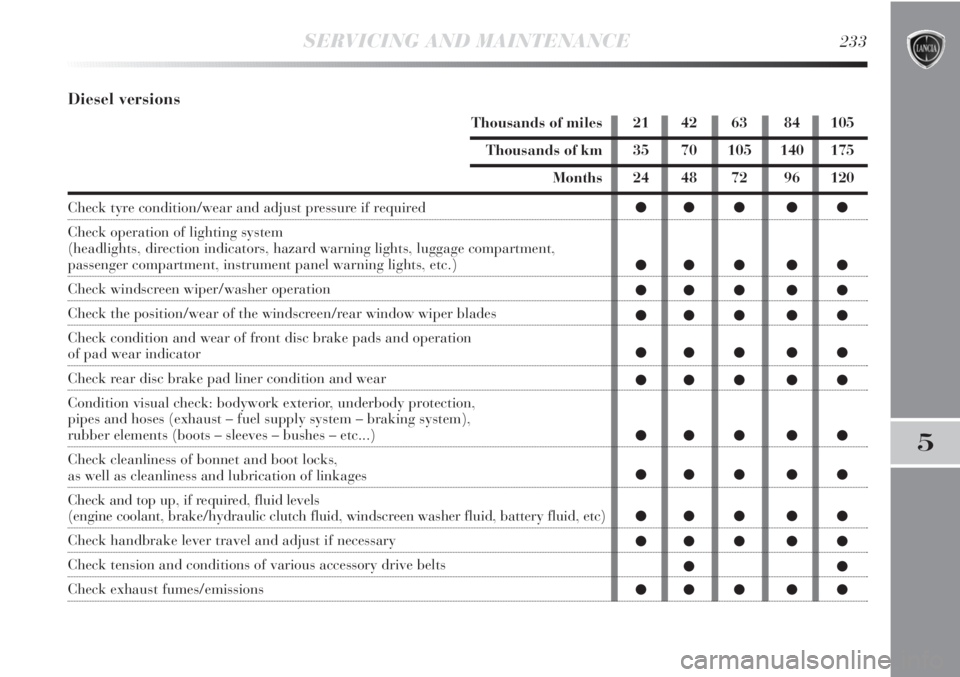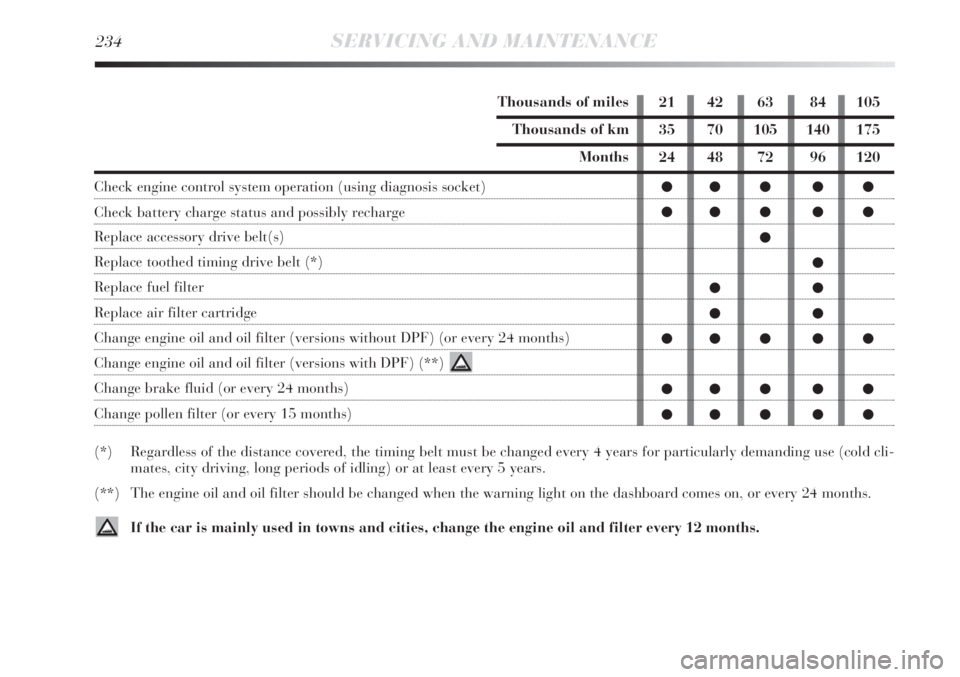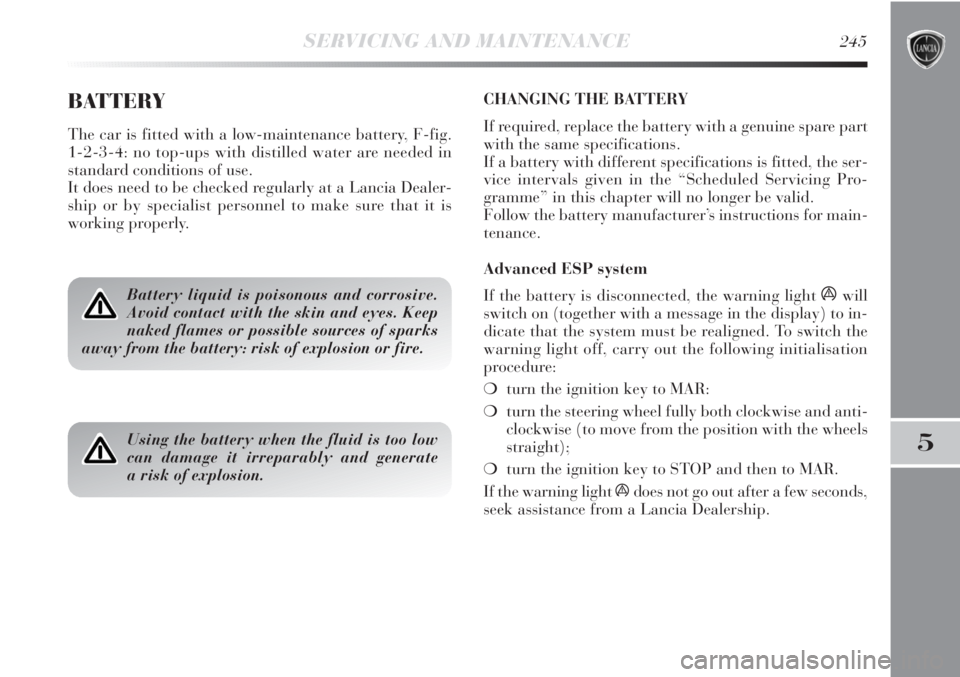warning light Lancia Delta 2012 Owner handbook (in English)
[x] Cancel search | Manufacturer: LANCIA, Model Year: 2012, Model line: Delta, Model: Lancia Delta 2012Pages: 295, PDF Size: 8.29 MB
Page 183 of 295

3
STARTING AND DRIVING181
HANDBRAKE
The handbrake lever is located between the two front
seats.
Pull the lever upwards to operate the handbrake, until
the vehicle is braked.
The car should be braked after a few clicks
of the lever; if it is not, contact a Lancia
Dealership to have it adjusted.
When the handbrake is on and the ignition key is at MAR,
the instrument panel warning light xwill come on.
Proceed as follows to release the handbrake:
❍slightly lift the handbrake and press release button
A-fig. 1;
❍keep button A pressed and lower the lever. The warn-
ing light xon the instrument panel will turn off.
Press the brake pedal when carrying out this operation
to prevent the car from moving accidentally. PARKING THE VEHICLE
Proceed as follows:
❍stop the engine and engage the handbrake;
❍engage a gear (on a slope, engage first gear if the car
is facing uphill or reverse if it is facing downhill) and
leave the wheels steered.
If the car is parked on a steep slope, it is also advisable
to block the wheels with a wedge or stone.
Do not leave the ignition key turned to MAR to prevent
draining the battery. Always remove the key when you
leave the car.
Never leave children in the unattended car. Always re-
move the ignition key when leaving the car and take it
out with you.
fig. 1L0E0072m
Page 192 of 295

190IN AN EMERGENCY
ENGINE STARTING
Go to a Lancia Dealership immediately if instrument
panel warning light
Yremains on constantly.
JUMP STARTING fig. 1
If the battery is flat, the engine may be started using an
auxiliary battery with the same capacity or a little higher
than the flat one.
fig. 1L0E0074m
Strictly avoid using a rapid battery charger
for jump starting: this could damage the
electronic systems and the engine fuel sup-
ply and ignition control units.
This starting procedure must be carried out
by expert personnel as incorrect manoeu-
vres can cause electrical discharges of con-
siderable intensity. Furthermore, battery fluid is
poisonous and corrosive: avoid contact with your
skin and eyes. Keep naked flames away from the
battery. No smoking. Do not cause sparks.
Page 201 of 295

IN AN EMERGENCY199
4
REPLACING A WHEEL
GENERAL INSTRUCTIONS
The car may be originally fitted with a space-saver wheel
(for versions/markets, where provided).
Wheel changing and correct use of the jack and spare
wheel call for some precautions as listed below.
The space-saver wheel (for versions/mar kets
where provided) is specific to your car, do not
use it on other models, or use the spare wheel
of other models on your car. The space-saver wheel
must only be used in case of emergency. Never use
it for more than strictly necessary and never exceed
80 km/h. On the space-saver wheel there is an or-
ange label, summarising the main warnings re-
garding space-saver wheel usage restrictions.
Never remove or cover the label. Never ap-
ply a hub cup on a space-saver wheel. The
following information is provided in four
languages on the label: IMPORTANT! FOR TEM-
PORARY USE ONLY! 80 KM/H MAX.! REPLACE
WITH STANDARD WHEEL AS SOON AS POS-
SIBLE. DO NOT COVER THIS LABEL.
If you change the type of wheel (alloy rims instead
of steel rims) you will have to change the entire set
of fastening bolts with another set of suitably sized
bolts.
Alert other drivers that the car is stationary
in compliance with local regulations: haz-
ard warning lights, warning triangle, etc.
Any passengers on board should leave the car, es-
pecially if it is heavily laden. Passengers should
stay away from on-coming traffic while the wheel
is being changed. If parked on a slope or rough sur-
face, chock the wheels with wedges or other suit-
able devices.
Page 233 of 295

18 36 54 72 90 108
30 60 90 120 150 180
24 48 72 96 120 144
●●● ●●●
●●● ●●●
●●● ●●●
●●● ●●●
●●● ●●●
●●● ●●●
●●● ●●●
●●● ●●●
●●● ●●●
●●● ●●●
●●
●●
SERVICING AND MAINTENANCE231
5
SCHEDULED SERVICING PLAN
Petrol versions
Thousands of miles
Thousands of km
Months
Check tyre condition/wear and adjust pressure if required
Check operation of lighting system (headlights, direction indicators,
hazard warning lights, luggage compartment, passenger compartment,
instrument panel warning lights, etc.)
Check windscreen wiper/washer operation
Check the position/wear of the windscreen/rear window wiper blades
Check condition and wear of front disc brake pads and operation
of pad wear indicator
Check rear disc brake pad condition and wear
Condition visual check: bodywork exterior, underbody protection,
pipes and hoses (exhaust – fuel supply system – braking system),
rubber elements (boots – sleeves – bushes – etc...)
Check cleanliness of bonnet and boot locks,
as well as cleanliness and lubrication of linkages
Check and top up, if required, fluid levels (engine coolant, brake/hydraulic
clutch fluid, windscreen washer fluid, battery fluid, etc)
Check handbrake lever travel and adjust if necessary
Visually inspect the condition of accessory drive belt(s)
Visually inspect the conditions of toothed timing belt
Page 235 of 295

SERVICING AND MAINTENANCE233
5
21 42 63 84 105
35 70 105 140 175
24 48 72 96 120
●● ● ● ●
●● ● ● ●
●● ● ● ●
●● ● ● ●
●● ● ● ●
●● ● ● ●
●● ● ● ●
●● ● ● ●
●● ● ● ●
●● ● ● ●
●●
●● ● ● ●
Diesel versions
Thousands of miles
Thousands of km
Months
Check tyre condition/wear and adjust pressure if required
Check operation of lighting system
(headlights, direction indicators, hazard warning lights, luggage compartment,
passenger compartment, instrument panel warning lights, etc.)
Check windscreen wiper/washer operation
Check the position/wear of the windscreen/rear window wiper blades
Check condition and wear of front disc brake pads and operation
of pad wear indicator
Check rear disc brake pad liner condition and wear
Condition visual check: bodywork exterior, underbody protection,
pipes and hoses (exhaust – fuel supply system – braking system),
rubber elements (boots – sleeves – bushes – etc...)
Check cleanliness of bonnet and boot locks,
as well as cleanliness and lubrication of linkages
Check and top up, if required, fluid levels
(engine coolant, brake/hydraulic clutch fluid, windscreen washer fluid, battery fluid, etc)
Check handbrake lever travel and adjust if necessary
Check tension and conditions of various accessory drive belts
Check exhaust fumes/emissions
Page 236 of 295

234SERVICING AND MAINTENANCE
Thousands of miles
Thousands of km
Months
Check engine control system operation (using diagnosis socket)
Check battery charge status and possibly recharge
Replace accessory drive belt(s)
Replace toothed timing drive belt (*)
Replace fuel filter
Replace air filter cartridge
Change engine oil and oil filter (versions without DPF) (or every 24 months)
Change engine oil and oil filter (versions with DPF) (**)
Change brake fluid (or every 24 months)
Change pollen filter (or every 15 months)
(*) Regardless of the distance covered, the timing belt must be changed every 4 years for particularly demanding use (cold cli-
mates, city driving, long periods of idling) or at least every 5 years.
(**) The engine oil and oil filter should be changed when the warning light on the dashboard comes on, or every 24 months.
If the car is mainly used in towns and cities, change the engine oil and filter every 12 months.
21 42 63 84 105
35 70 105 140 175
24 48 72 96 120
●● ● ● ●
●● ● ● ●
●
●
●●
●●
●● ● ● ●
●● ● ● ●
●● ● ● ●
Page 247 of 295

SERVICING AND MAINTENANCE245
5
BATTERY
The car is fitted with a low-maintenance battery, F-fig.
1-2-3-4: no top-ups with distilled water are needed in
standard conditions of use.
It does need to be checked regularly at a Lancia Dealer-
ship or by specialist personnel to make sure that it is
working properly.
Battery liquid is poisonous and corrosive.
Avoid contact with the skin and eyes. Keep
naked flames or possible sources of sparks
away from the battery: risk of explosion or fire.
Using the battery when the fluid is too low
can damage it irreparably and generate
a risk of explosion.
CHANGING THE BATTERY
If required, replace the battery with a genuine spare part
with the same specifications.
If a battery with different specifications is fitted, the ser-
vice intervals given in the “Scheduled Servicing Pro-
gramme” in this chapter will no longer be valid.
Follow the battery manufacturer’s instructions for main-
tenance.
Advanced ESP system
If the battery is disconnected, the warning light
áwill
switch on (together with a message in the display) to in-
dicate that the system must be realigned. To switch the
warning light off, carry out the following initialisation
procedure:
❍turn the ignition key to MAR:
❍turn the steering wheel fully both clockwise and anti-
clockwise (to move from the position with the wheels
straight);
❍turn the ignition key to STOP and then to MAR.
If the warning light ádoes not go out after a few seconds,
seek assistance from a Lancia Dealership.
Page 293 of 295

LIST OF CONTENTS291
7
Ty r e s
– inflation pressure ............270
– provided as standard ......268
– reading tyre markings ....266
– replacement ....................199
– Rim Protector .................268
– snow tyres ......................268
Using the manual
gearbox .............................182
Warning lights on panel ..... 11
Weights ...............................273
Wheel (changing) ................199
Wheel rims
– reading rim markings .....268
Wheels ................................266
When parked ......................181Window cleaning washer .... 68
Windows (cleaning) ............249
Windscreen wipers
– blades .............................245
– control ............................ 68
– nozzles ...........................246 Supply ................................263
Suspension ..........................265
– Reactive Suspension
System ...........................107
Symbols .............................. 40
T.P.M.S. system ..................129
Technical specifications .......257
Third brake lights
(bulb replacement) ............214
Top speeds ..........................272
Towing the car ....................227
Towing trailers ....................185
Transmission .......................264
Trip Computer .................... 38
TTC system ........................118